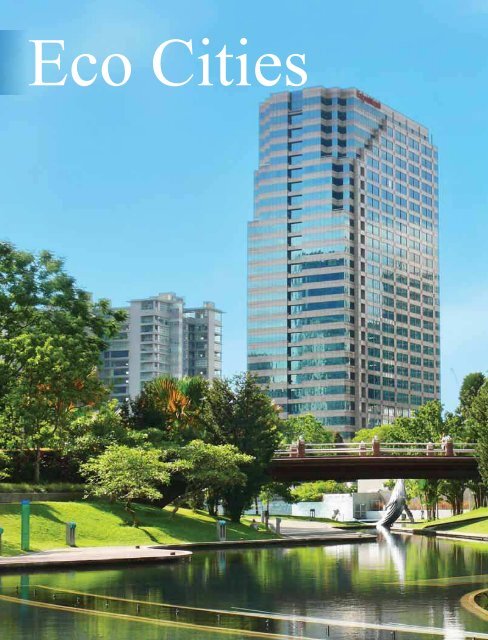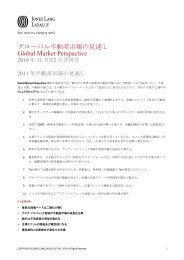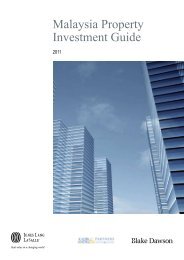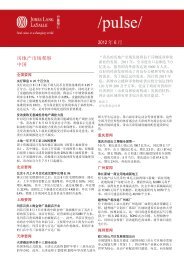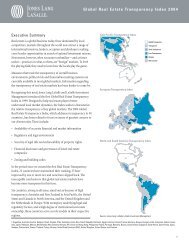Global Sustainability Perspective magazine - Jones Lang LaSalle
Global Sustainability Perspective magazine - Jones Lang LaSalle
Global Sustainability Perspective magazine - Jones Lang LaSalle
You also want an ePaper? Increase the reach of your titles
YUMPU automatically turns print PDFs into web optimized ePapers that Google loves.
<strong>Global</strong> <strong>Sustainability</strong> <strong>Perspective</strong><br />
Eco Cities<br />
June 2012<br />
The description “Eco” City has a strong,<br />
optimistic, almost personal ring to it, as it<br />
should have, being derived from the ancient<br />
Greek term oikos meaning a “place to live.”<br />
When Richard Register first coined the term in his 1987 book “Ecocity<br />
Berkeley: Building Cities for a Healthy Future,” most of us would not<br />
have foreseen the extent to which his thinking would eventually come to<br />
influence the development of cities, nor how the changes he advocated<br />
in the way cities are planned, used, lived and worked in would become<br />
such imperatives. And even while the term Eco City may not yet be<br />
wholly, comprehensively or consistently defined it has certainly entered<br />
the mainstream and is used extensively as the backdrop for a wide<br />
range of activities in urban sustainability.<br />
The debate around what constitutes an Eco City has been gathering<br />
momentum since the early nineties. Eco City summits in Montreal,<br />
Istanbul, Shenzhen, Curitiba and others have explored philosophy,<br />
policy and practice, while challenging thinkers like Herbert Giradet and<br />
Mark Roseland have produced an extensive range of literature and<br />
guidance on creating Eco and sustainable cities.<br />
In the last five years or so it has been the likes of the ambitious and<br />
high profile UAE Masdar City and the Sino-Singapore Tianjin Eco-city<br />
which have gained the headlines. These showcase examples are rich<br />
in intelligence around new technologies, innovative urban planning<br />
processes, 21st century mobility, and funding mechanisms. They also<br />
demonstrate the deep challenges of carbon neutrality and of proving<br />
commercial returns.<br />
But while these all inclusive models of urban sustainability are pushed,<br />
pummeled and pressed to prove their durability, a huge range of<br />
cities are testing micro models of Eco district and neighborhood<br />
development. They are embracing in a more local way the core Eco<br />
City principle of minimizing environmental impact and maximizing<br />
social and economic good.<br />
This incremental approach reflects both the difficulties of trying to create a<br />
universal blueprint of the Eco City and the practicalities of large scale<br />
transformation in established cities. What is clear however, is that Eco<br />
City metrics of performance will be as important to the market as the<br />
measurement of the value add of green buildings. Understanding risks,<br />
returns and benchmarking one city against another, will be an important<br />
feature in the Eco City arena. But how can we measure what is not well<br />
4 1<br />
<strong>Jones</strong> <strong>Lang</strong> <strong>LaSalle</strong><br />
defined? This is an uncomfortable question from the purist researchers’<br />
viewpoint, but pragmatism demands that some measures are better than<br />
none and experience tells us that markers in the ground are important.<br />
Companies like Siemens and their Sustainable Cities Index and Mercer with<br />
their Eco City ranking have begun the process of measurement and<br />
comparison. CDP Cities with whom <strong>Jones</strong> <strong>Lang</strong> <strong>LaSalle</strong> is proud to partner<br />
are now delving very deeply into a very wide range of sustainability practices<br />
in cities. Forty-eight cities are now filling in a very detailed questionnaire<br />
about sustainability aspects of governance, strategy, finance, partnerships<br />
and risk awareness amongst many other issues. The results of the survey<br />
give a very clear insight into the different measures of challenge and<br />
progress across cities and the very different routes they are taking<br />
towards a sustainable future.<br />
Our <strong>Global</strong> <strong>Sustainability</strong> <strong>Perspective</strong> comments on many of the issues<br />
that stem from thinking about the ultimate goal – for all cities to be Eco<br />
in the sense of working together towards a built and living environment that<br />
gives environmental, social and economic quality now and protects it for<br />
future generations. We look at the current gaps between the commercial<br />
and city hall views with regards to creating a common approach to instilling<br />
sustainable behaviors and outcomes, at the extensive activity in China, the<br />
injection of major sustainable schemes in the London Olympics and inland<br />
Ports in the USA and at Green City mobility in Paris.<br />
The transformation of our cities will largely be through incremental change,<br />
through the spread of best practice and through assessing and measuring<br />
what works and what is, bluntly, effective and affordable. The likelihood is<br />
that in the next few years this column will be covering the definition of not<br />
just Eco Cities, but how we assess affordability in the light of continuing<br />
environmental and social challenge.<br />
For further information please contact:<br />
Rosemary Feenan<br />
Head of <strong>Global</strong> Research Programmes<br />
Rosemary.Feenan@eu.jll.com


